Advertisement
Contemporary Artist Titus Kaphar On How Art Can Address Injustice
Resume
Artist Titus Kaphar won the Rappaport Prize from the deCordova Sculpture Park and Museum, which is awarded to a contemporary artist with “strong connections to New England and a proven record of achievement.”
Kaphar has exhibited at MoMA, the National Gallery and, this fall, will debut a new piece at Mass MoCA. His work alters the way we see history with his provocative paintings, sculptures, drawings and installations.
We speak with him about the way his art interacts with the past, how artists should engage in the national conversation on national monuments and his experiences as black artists working today.
Guest
Titus Kaphar, contemporary artist
Interview Highlights
On why history is an impetus for his artwork:
"I spend a lot of time at museums. I take my kids very frequently... I went to the Natural History Museum in New York and, as we were approaching the stairs, my son noticed that giant sculpture that's out front. That sculpture that has Teddy Roosevelt sitting on a horse, looking bold, and strong, and holding a horse with full control. On the left and the right of him are a Native American and an African-American.
"As we were walking up to the museum, my son asked this question. He said, 'Dad, how come he gets the ride and they have to walk?' We had a really long conversation about American history, about injustice and, fundamentally, for a 9-year-old ... the real issue was very simple: The fact that that doesn't look fair.
"After having spent that time with with my sons, I decided that I needed to start a body of work that had some way of addressing this injustice that we see again and again in our national and our national monuments."
On how he believes artists should be included in this national reckoning over our historical monuments:
"It seems to me that we are having a national conversation about art but not including artists. It seems quite strange to me that the very people who create these objects that we're debating about are not involved. So, right now, we're having a conversation that is primarily binary. Either we keep these sculptures up or we tear them down. I don't think it has to be binary. I think there is another option.
"What I'm proposing is that we actually create amendments. We take those sculptures in the squares that they exist and we engage our contemporary artists to make new works that stand next to those old works. Takes the originals off the platforms, put them side by side and turn those spaces ... into centers for civil, civic dialogue.
"De-accessioning these works is just simply not enough ... and it's also not enough to just take them down and put up something new. We need to remember where we came from. We need to also remember that we are trying to get someplace different, someplace we have never been before in this country."
On his whitewash paintings, where white paint is used to cross out white subjects in 18th and 19th century replica paintings, leaving the black subjects as the focus:
"The important thing to understand about whitewashing and painting and — in the way that I do it — is it's kind of temporary. The materials that I put inside of the paint, it becomes more translucent over time. As I'm whitewashing these figures, they're not permanently removed. I'm trying to shift the viewer's gaze for a moment.
"When I did the TED Talk [about this technique], I finished a painting [and] I stepped off stage. The thing that was most shocking to me is that several people came up to me after and said, 'You know, I didn't even see that black character until you whited out everything else.' We are trained to view these paintings in a particular way.
"The hierarchy of the compositional structure is effective. These characters, that are often in the margins of the painting — we ignore, we miss. This whitewashing allows us to gaze at them [and] to consider them just for a moment. Hopefully, that shifting allows to spend time in the margins in other paintings in the future."
This segment aired on August 20, 2018.

